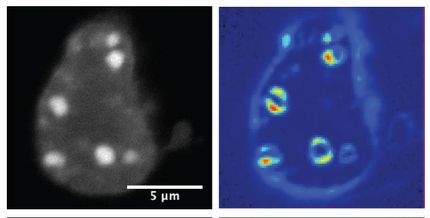Potential new drug class hits multiple cancer cell targets, boosting efficacy and safety
MYC is a regulator gene. It controls the expression of other genes and codes transcription factors or proteins involved in many fundamental cellular processes. It's also among the most frequently altered genes found in cancer, making it a profoundly attractive target for cancer therapies.
But MYC has proved very complicated and an elusive therapeutic target. Researchers at the University of California San Diego School of Medicine and Moores Cancer Center, in collaboration with colleagues at Rady Children's Hospital-San Diego, the University of Colorado School of Medicine and SignalRx, a San Diego-based biopharmaceutical company, describe a potential new class of anti-cancer drugs that inhibit two or more molecular targets at once, maximizing therapeutic efficiency and safety.
"Most anti-cancer drugs have a single target. They try to do one thing, such as block a single receptor or signaling pathway," said study co-senior author Donald L. Durden, MD, PhD, professor in the Department of Pediatrics at UC San Diego School of Medicine and associate director for pediatric oncology at Moores Cancer Center at UC San Diego Health. "This paper is proof-of-concept of a completely different mode of drug discovery clearly separated from the standard practice of one drug, one target."
Specifically, Durden and colleagues engineered a small molecule called SF2523 in silico, using molecular modeling crystal structure and nuclear magnetic resonance imaging, to simultaneously disrupt two key MYC-mediating factors that promote cancer cell growth. Those two factors are PI3K, an enzyme, and BRD4, a protein.
In cell and mouse models, they found SF2523 concomitantly inhibited PI3K and BRD4, blocking MYC activation and expression and markedly inhibiting cancer growth and metastasis, with improved efficacy and less toxicity to the host.
"This is a 'first in class' approach to achieve a maximum inhibition of MYC in the treatment of the multitude of cancers known to be driven by the MYC oncogene," said Durden. "These findings suggest that dual-activity inhibitors are a highly promising lead compound for developing new anticancer therapeutics."
Original publication
Original publication
Forest H. Andrews, Alok R. Singh, Shweta Joshi, Cassandra A. Smith, Guillermo A. Morales, Joseph R. Garlich, Donald L. Durden, and Tatiana G. Kutateladze; "Dual-activity PI3K–BRD4 inhibitor for the orthogonal inhibition of MYC to block tumor growth and metastasis"; PNAS; 2017
Topics
Organizations
Other news from the department science

Get the life science industry in your inbox
By submitting this form you agree that LUMITOS AG will send you the newsletter(s) selected above by email. Your data will not be passed on to third parties. Your data will be stored and processed in accordance with our data protection regulations. LUMITOS may contact you by email for the purpose of advertising or market and opinion surveys. You can revoke your consent at any time without giving reasons to LUMITOS AG, Ernst-Augustin-Str. 2, 12489 Berlin, Germany or by e-mail at revoke@lumitos.com with effect for the future. In addition, each email contains a link to unsubscribe from the corresponding newsletter.





















































